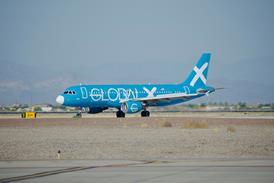Honeywell has solidified its lead position in the advanced vision and navigation arena with the launch of two products for high-end cockpits.
Soon to be available for Gulfstream PlaneView cockpits is Honeywell's second-generation synthetic vision upgrade. Dubbed "Cert Foxtrot", the evolution, certificated in September, also offers enhanced navigation in the form of satellite-based augmentation system approaches, required navigation performance (RNP) to as tight as 0.1nm (0.18km), XM weather and paperless charts.
For Dassault, the new EASy II flightdeck will feature many of the same enhancements as well as synthetic vision for the first time in the EASy-equipped cockpits of the Falcon 900 and Falcon 2000 families as well as for the 7X.
Production for the Gulfstream line is expected early next year, says Chad Cundiff, vice-president of crew interface systems for Honeywell.
Dassault expects to certificate EASy II for the Falcon 900EX in the first quarter of 2010, with production to start in June. Certifications for the Falcon 2000 and 7X will follow about one year later, says Woody Saland, manager of technical programmes for Dassault Falcon.
Improvements to Honeywell's SV-PFD 2.0 synthetic vision system for PlaneView mean that terrain is now rendered under the horizontal situation indicator on the bottom of the primary flight display, increasing situational awareness. Also included are more detailed runway displays.
Key to optimising efficiency, however, will be the new navigation features for both airframers. The optional enhanced navigation package for Gulfstream includes wide area augmentation system lateral precision with vertical guidance (LPV) approach capability, which allows non-precision instrument approaches typically down to 250ft (76m) above the ground.
Cert Foxtrot also takes precision approaches to the next level, with RNP 0.1nm capability and Honeywell Go Direct services to help operators qualify to fly special aircrew and aircraft authorisation required approaches.
Honeywell has also made software changes to the inertial navigation system that allow for a "gentle" degradation of the aircraft's computed position solution when the GPS signal is lost, alleviating the need to immediately abandon a GPS approach.
New for EASy II is an auto-descent mode that will activate automatically in the event of cabin depressurisation at high altitudes.
Source: Flight Daily News























